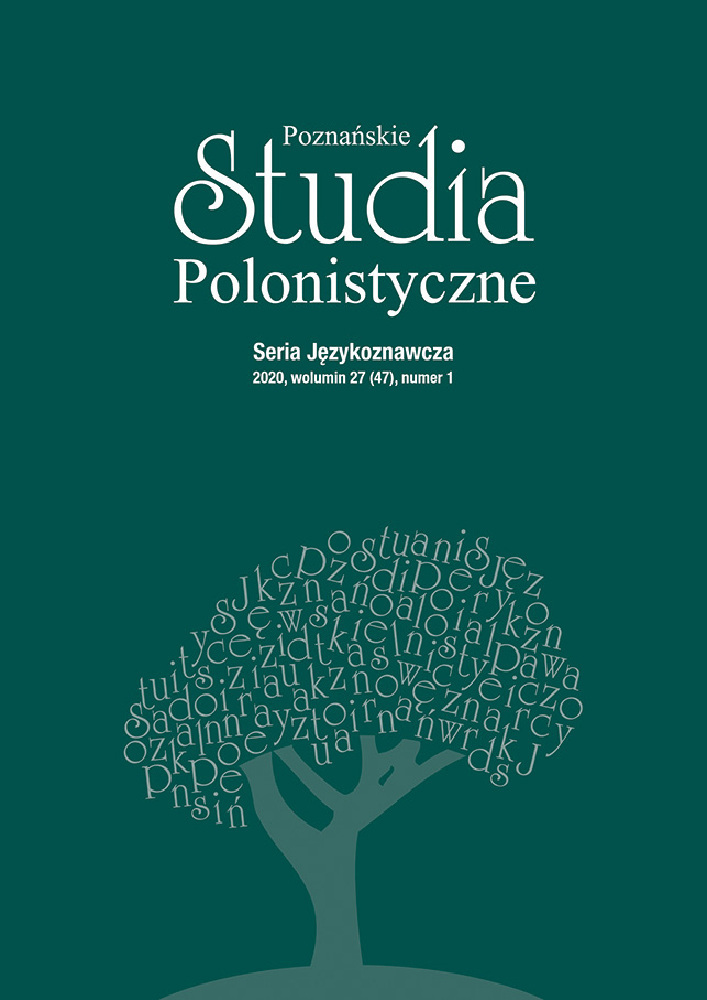Abstrakt
The article analyses the morphological and syntactic expression of the causator (or cause) in the communicative situations of causation of joy in the Polish language. By causation we mean the semantic category which expresses the causal relationships between the fundamentals of non-linguistic reality. The purpose of this study is to analyse the syntactic structure of communicative situations of causation of joy, on the semantic level of which there are such actants as: agent, experiencer, causator (or cause). All of the analysed constructions were divided into three groups: agentive split constructions, agentive unsplit constructions and non-agentive constructions. Split constructions refer to those in which the agent and causator are separate actants, while unsplit ones refer to those in which these semantic roles are combined into one actant. The results of the study show that the most numerous group among the examples is that of non-agentive constructions.
Bibliografia
Słowniki
NKJP – Narodowy Korpus Języka Polskiego, http://nkjp.pl [dostęp: 2–20 czerwca 2019].
USJP – Stanisław Dubisz, red., Uniwersalny słownik języka polskiego, t. 1–4, Wydawnictwo Naukowe PWN, Warszawa 2008.
Literatura
Apresyan Valentina (2013), Semantika emotsionalnykh kauzativov: status kauzativnogo komponenta, Kompyuternaya lingvistika i intellektualnye tekhnologii, nr 12 (19), s. 43–57.
Grafova Tatiana i dr. (1991), Chelovecheskiy faktor, Institut yazykoznaniya, izdatelstvo Nauka, Moskva.
Izard Kerrol (2012), Psikhologiya emotsiy, Spb., Piter.
Kuznetsova Elena (2017), K voprosu o sootnoshenii yazykovogo predstavleniya emotsiy i kauzatsii v predlozheniyakh. peredayushchikh emotsionalnoe sostoyaniye v angliyskom yazyke, Tambov, https://tinyurl.com/yaaseybm [dostęp: 2 lipca 2019].
Krasavskiy Nikolay (2010), Kontsept «radost» v russkoy lingvokulture (na materiale slovarnykh statey i assotsiativnogo slovarya), Volgograd, https://tinyurl.com/ybhf8czf [dostęp: 6 marca 2020]
Mikheeva Natalia (2007), Kauzatsiya emotsionalnogo sostoyaniya i emotsionalnogo otnosheniya v ispanskom yazyke, dissertatsiya na soiskaniye uchenoy stepeni kandidata filologicheskikh nauk, Moskva, s. 45–46.
Mikołajczuk Agnieszka (2013), O radości w ujęciu lingwistycznym: z problemów semantycznych badań porównawczych, Lublin, https://tinyurl.com/y7yn47h5[dostęp: 14 marca 2020].
Paducheva Elena (2013), Russkoe otritsatelnoe predlozheniye, Yazyki slavyanskoy kultury. Moskva, s. 61.
Polezhayeva Svetlana (2013), Semantiko-grammaticheskiye osobennosti emotivnykh glagolov, opisyvayushchikh kauzatsiyu subektom emotsionalnogo perezhivaya u sebya samogo i drugogo litsa, Tambov, https://tinyurl.com/ydzxoe9z [dostęp: 6 marca 2020].
Zakusylo Daryna (2018), Predykaty zi znachennyam ‘kauzatsiia radosti’ v polskii movi, Komparatyvni doslidzhennia slovianskykh mov ta literatur, s. 34–42.
Zolotova Galina (1973), Ocherk funktsionalnogo sintaksisa russkogo yazyka, izdatelstvo Nauka. Moskva.
Licencja
Autorzy
Autor oświadcza, że przysługują mu osobiste i majątkowe prawa autorskie do utworu publikowanego w czasopiśmie „Poznańskie Studia Polonistyczne. Seria Językoznawcza”, oraz że nie są one ograniczone w zakresie objętym umową autorską, oraz że utwór jest dziełem oryginalnym i nie narusza majątkowych lub osobistych praw autorskich innych osób, ani innych praw osób trzecich, w tym dóbr osobistych.
Autor(zy) zachowują pełne prawa do dalszego, swobodnego rozporządzania utworem, udzielając Uniwersytetowi im. Adama Mickiewicza w Poznaniu niewyłącznej i nieodpłatnej licencji CC BY-ND 4.0 Międzynarodowe na korzystanie z utworu bez ograniczeń terytorialnych przez czas nieokreślony na określonych umową autorską polach eksploatacji.
Użytkownicy
Zainteresowani użytkownicy internetu uprawnieni są do korzystania z utworów opublikowanych od 2016 roku w „Poznańskich Studiach Polonistycznych. Serii Językoznawczej” pod następującymi warunkami:
- uznanie autorstwa – obowiązek podania wraz z rozpowszechnionym utworem informacji, o autorstwie, tytule, źródle (odnośniki do oryginalnego utworu, DOI) oraz samej licencji;
- bez tworzenia utworów zależnych – utwór musi być zachowany w oryginalnej postaci, nie można bez zgody twórcy rozpowszechniać np. tłumaczeń, opracowań.
Do wszystkich tekstów opublikowanych przed 2016 r. prawa autorskie są zastrzeżone.
Inne
Uniwersytet im. Adama Mickiewicza w Poznaniu zachowuje prawo do czasopisma jako całości (układ, forma graficzna, tytuł, projekt okładki, logo itp.).
